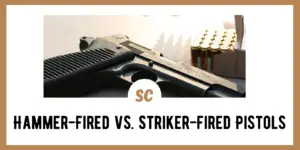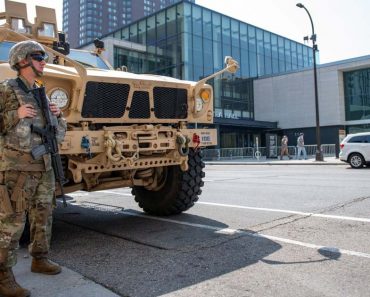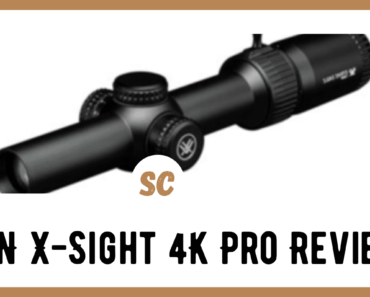If you are considering purchasing a new pistol, the topic of hammer-fired pistols vs. striker-fired pistols will always come up. Before you make a final decision on which style of pistol you prefer, you need to educate yourself about the way each pistol design works, and the disadvantages of each.
Striker-fired pistols are not a new phenomenon in the pistol shooting world. This type of pistol action has been around for decades but really came into prominence with Glock introducing their first pistol, the Glock 17. Striker-fired guns took an immediate jump in popularity at that time.
Hammer-fired pistols are familiar to almost everyone. You would be hard-pressed to find a shooter who doesn’t recognize the famous Model 1911 pistol. Millions of these workhorse .45 caliber semi-automatic pistols were produced during World War II. These Model 1911s may be the most famous hammer-fired pistols in the world.

Hammer-Fired Pistols Operations
If you are old enough, you’ll remember the detective shows and cowboy movies that showcased a variety of hammer-fired revolvers, and many of us were introduced to pistol shooting with a twenty-two caliber revolver.
Semi-automatic hammer-fired pistols are not new. The infamous Mauser C96, otherwise known as the “broom handle Mauser” for its distinctive round wooden handle, was one of the more successful early attempts at a self-loading pistol with a hammer.
The Basic Mechanism of a Hammer-Fired Pistol
The modern hammer-fired semi-automatic pistol mechanism is relatively unchanged from John Browning’s original 1911 pistol design. Without going into a lot of engineering details. the design has several distinct features.
- The action is recoil-operated.
- The slide mechanism houses the barrel, ejector, and firing pin.
- Bullets are fed into the pistol from a magazine, usually enclosed in the pistol grip.
- After firing, the recoil generated drives the slide backward, ejecting the spent casing, recocking the exposed hammer, and picking up a fresh cartridge from the magazine as it returns to battery position.
- Pulling the trigger again releases the hammer which moves forward to strike the firing pin and repeat the cycle.
To initiate the sequence, the slide on the hammer-fired pistol must be manually operated to place an unfired cartridge in the chamber. The hammer may be automatically returned to the safe position or may remain cocked, ready for a shot.
Innovations in Safety On Hammer-Fired Pistols
Many of the early versions of hammer-fired pistols automatic pistols had some serious weaknesses. In particular, if the hammer were undocked, it tended to rest against the firing pin. An accident strike on the hammer could cause a negligent discharge. This was most often seen if the pistol was dropped.
To prevent these negligent discharges, several approaches are used. Some pistol designs incorporate grip safeties. This safety on the back of the grip surface must be depressed for the hammer to engage the firing pin. Other designs incorporate a trigger or hammer disconnect that prevents the hammer from moving unless all the safeties are disengaged. These design changes have proven effective in almost entirely eliminating negligent discharges in recent years.
Glock firearms feature a fully automatic safety system. A lever on the trigger must be depressed to engage the trigger with the rest of the firing system. There is no need to disengage a manual safety, which eliminates many moving parts from other hammer-fired safety systems.
Types of Modern Hammer-Fired Pistols
Modern hammer-fired pistols come in two flavors. These two types of hammer-fired semi-automatic pistols are known as single-action pistols and double-action pistols. There is a significant difference in the way these two types of hammer-fired guns operate from a shooter’s standpoint.
The Single Action Pistol Variation
The easiest way to differentiate between single-action and double-action pistols is to understand what the trigger pull actually does on each type of pistol. On a single-action pistol, the trigger performs one function and one function only, releasing the hammer to fire the pistol.
A single-action pistol requires that the hammer be moved to the firing position before each shot can be taken. This is accomplished on most single-action revolvers by manually pulling the hammer back to the cocked position. On modern semi-automatic single-action pistols, racking the slide the first time cocks the hammer as well. Each subsequent shot resets the hammer.
The Double Action Pistol Variation
As you might expect from the name, the trigger on a double-action weapon has two functions. The trigger does release the hammer to fire the pistol. The second function is to cock the hammer when ready to fire a round from the pistol. Several hammer-fired weapons operate as double-action pistols.
Typically, racking the slide to place an unfired cartridge in the chamber also allows the hammer to come back to the safe position where it is prevented from striking the firing pin by a disconnect or a hammer block.
To fire the first shot, the first trigger pull cocks the hammer to the firing position. At the end of the trigger pull, the disconnect or hammer block is disengaged, and the hammer falls to strike the firing pin. The recoil of the pistol works the action to expel the spent cartridge, cock the hammer, and load a new cartridge ready for firing.
Striker-Fired Pistol Operations
Striker-fired pistols are distinguished by the lack of a hammer at the rear of the slide. The entire firing mechanism is housed inside the slide. Many people prefer a striker-fired gun for this very reason. With no hammer, the possible snag problems of a hammer are removed from the equation.
It would appear that the lack of a hammer and the required mechanisms to cock the hammer during a double-action shot would be an advantage. What is missing is the ability to make a striker-fired pistol safe by decocking the hammer. Striker fires handguns gained popularity after Glock introduced their first striker-fired handguns.

The Basic Mechanism of Striker-Fired Guns
Striker mechanisms don’t rely on the inertia and mass of a hammer to drive the firing pin into the cartridge primer like hammer-fired handguns. Instead, the firing pin is driven forward when the trigger is pulled, and the spring tension causes the firing mechanism to strike the primer and send the bullet on its way. The spring-loaded firing pin on striker-fired guns is the fundamental difference between a striker-fired handgun and a hammer-fired gun.
Historically, there were some problems with the early striker-fired weapons. On some occasions that safety mechanism would fail if a pistol were dropped or the trigger was snagged during re-holstering. This caused several negligent discharges. The gun manufacturing industry responded with new and better safety innovations for these pistols
A striker-fired gun operates much like a single-action semi-automatic firearm. The same basic mechanics are required.
- The slide on a striker-fired pistol must be racked to load a round into the chamber and to put the firing pin under spring tension ready to fire.
- Pulling the trigger deactivates any safety mechanisms and releases the firing mechanism, allowing the spring to drive the firing pin forward to strike the cartridge’s primer.
- The recoil from the fired cartridge drives the slide mechanism back, ejecting the spent casing, resetting the trigger mechanism, and then picking up a fresh cartridge as the slide returns forward.
The striker mechanism on most modern semi-automatic striker-fired pistols includes built-in safety mechanisms that prevent accidental discharges.
Safeties and the Striker-Fired Pistol
Many early striker-fired pistols included manual safety buttons or levers that prevented the gun from operating if the safety was engaged. Gun manufacturers began offering internal automatic safety features as technology and development progressed. There are a wide array of different safety concepts now employed on the standard striker-fired pistol. Among these are:
- Trigger lever safeties such as those found on Glock pistols.
- Grip safeties that lock the firing mechanism if the gun is not properly gripped to disengage the locking mechanism.
- Manual safeties that must be unlocked before a shot can be taken and relocked to put the gun into a safe mode.
Modern striker mechanism pistols are some of the safest handguns available. Striker-fired handguns have a great safety record and, when handled properly, rarely have problems with negligent discharges.
Advantages and Disadvantages of a Hammer-Fired Pistol
Both types of pistols have their advocates and their detractors. It is often difficult to get an unbiased view of striker vs. hammer-fired weapons, and most gun owners have their personal feelings about this question. Personally, I have both kinds of semi-automatic pistols in my collection. I am not so concerned about the type of firearm I carry as I am about the functionality, dependability, and the way it feels in my hand when I shoot.
With that said, I do understand the advantages and disadvantages of both types of pistols. I will offer what I think is an objective consideration of the pros and cons and hope that opinion helps you with your decision.
Striker-Fired Pistol Advantages
- Striker mechanisms are typically less complex and have fewer moving parts.
- The trigger pull on most striker pistols is more consistent than on a hammer-fired handgun.
- A striker pistol is often easier to concealed carry than a pistol with a hammer.
- Striker type handguns often have a lower bore axis, which can aid target acquisition and aiming.
- If concealed carry is a concern, most compact and subcompact versions of popular firearms use striker mechanisms to save weight and bulk
- Most pistols that have a striker also use a polymer frame that makes the weapon lighter.
- Fewer moving parts inside the pistol equates to less maintenance and fewer operating problems.
I routinely carry a Glock 43. This subcompact 9mm pistol is striker-fired and has proven exceptionally dependable and accurate. For a concealed carry pistol, I couldn’t ask for anything better.

The Disadvantages of a Striker Mechanism
- For the inexperienced shooter, the light trigger pull of many striker mechanisms can be a problem that leads to inadvertent discharges.
- Most striker mechanisms lack any sort of external safeties. This makes trigger discipline and range safety a paramount factor.
- Light trigger pulls can cause inadvertent double taps during shooting if the shooter is unfamiliar with the pistol.
The Advantages of a Hammer-Fired Pistol
- A hammer gives a quick and easy confirmation of the state of a pistol. You can see at a glance if the hammer is cocked and ready to fire.
- With the hammer cocked, the pistol trigger pull is usually relatively light and the release crisp.
- Pistols with a hammer can be found in both single and double action. This gives more options to shooters who opt for a pistol with a hammer.
I have a Sig Sauer P250, which I still occasionally carry if I want a larger-capacity pistol than the Glock 43. It is a double-action pistol with an abbreviated hammer. I like the way this gun performs and shoots.
The Disadvantages of a Hammer
- Full hammers can be a snag hazard, especially when you conceal carry.
- The long and sometimes heavier trigger pull of the first shot can be a problem for some shooters.
- Some semi-auto guns with hammers operate in double action only, and the hammer cannot be manually cocked.
- Firing a double-action mechanism involves more steps than a single-action pistol. On many double-action pistols, the manual safety must be disengaged, adding a step to the firing process.
- Most double-action-only pistols also have a decocking mechanism to allow the hammer to come forward without firing the round in the chamber. This can be an unfamiliar step to many shooters.
Which Would I Chose if I Could Only Have One Pistol?
In the end, if it came down to choosing one type of semi-auto pistol over another, I would choose the striker mechanism. The simpler operation and the sleeker and thinner frames that typify this type of pistol make them my choice. I enjoy shooting both styles of the pistol but, in the end, my go-to self-defense and personal carry pistols all have striker mechanisms.







![The Tunguska Event [PODCAST]](https://survivalcove.com/wp-content/themes/mts_sociallyviral/images/nothumb-sociallyviral-featured.png)




![Amber Landry and Emily Livingston: Women’s Survival [PODCAST] Amber Landry and Emily Livingston: Women’s Survival [PODCAST]](https://survivalcove.com/wp-content/uploads/2021/10/Packing-Goats-Hunting-Survival-370x297.jpg)



















